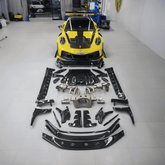Carbon Fiber vs Leather: Which is Better?
When it comes to choosing between carbon fiber and leather, it can be difficult to determine which material is better. Both materials have their unique properties and features that make them suitable for different applications. In this blog post, we'll explore the benefits and drawbacks of both materials to help you make an informed decision.
Carbon Fiber
Carbon fiber is a high-strength, lightweight composite material that is made by weaving together carbon fibers and resin. It has been used in aerospace, automotive, and sporting equipment applications for decades due to its excellent strength-to-weight ratio. Carbon fiber is also known for its stiffness, durability, and resistance to corrosion.
Benefits of Carbon Fiber
Strength and Durability: Carbon fiber is incredibly strong and can withstand high stresses and impacts without breaking. This makes it an ideal material for high-performance applications like aerospace, automotive, and sporting equipment.
Lightweight: Carbon fiber is one of the lightest materials available, which is why it is commonly used in aerospace applications to reduce weight and improve fuel efficiency.
Resistance to Corrosion: Carbon fiber is highly resistant to corrosion, which means it can withstand exposure to harsh environments without deteriorating.
Drawbacks of Carbon Fiber
Expensive: Carbon fiber is a high-end material that is relatively expensive compared to other materials like aluminum, steel, and plastic.
Difficult to Repair: Carbon fiber can be challenging to repair if it gets damaged, which can be a significant drawback for applications where repairability is essential.
Leather
Leather is a natural material that is made by tanning animal hides. It has been used for thousands of years to make clothing, furniture, and accessories due to its durability, flexibility, and aesthetic appeal. Leather is known for its unique texture, smell, and feel, which make it a popular choice for high-end products.
Benefits of Leather
Durability: Leather is a highly durable material that can withstand daily wear and tear. It is resistant to water, fire, and abrasions, making it a suitable material for a wide range of applications.
Aesthetic Appeal: Leather has a unique texture, smell, and feel that make it a popular choice for high-end products like luxury cars, designer handbags, and furniture.
Sustainability: Leather is a natural material that can be produced sustainably by using eco-friendly tanning processes and sourcing hides from responsibly managed farms.
Drawbacks of Leather
Maintenance: Leather requires regular maintenance to keep it looking good and prevent it from drying out, cracking, or fading. This can be time-consuming and expensive for some applications.
Environmental Impact: Leather production has a significant environmental impact, particularly in terms of water usage, chemical pollution, and greenhouse gas emissions.
Conclusion
Both carbon fiber and leather have their unique benefits and drawbacks, and the choice between the two ultimately depends on the specific application. Carbon fiber is an excellent choice for high-performance applications where strength, durability, and lightweight are essential, while leather is a suitable material for products that require aesthetic appeal, durability, and sustainability. In the end, it's up to you to determine which material is best for your needs based on your priorities and budget.








